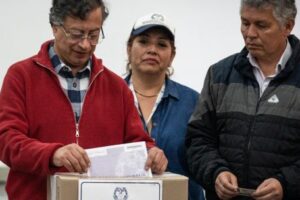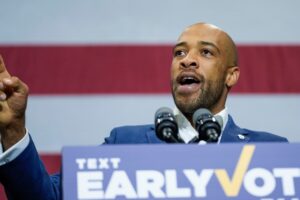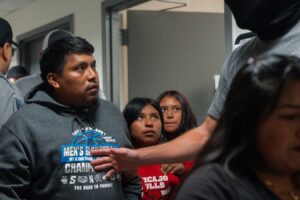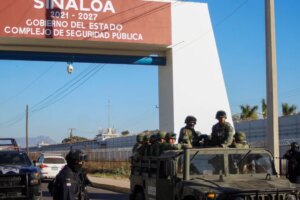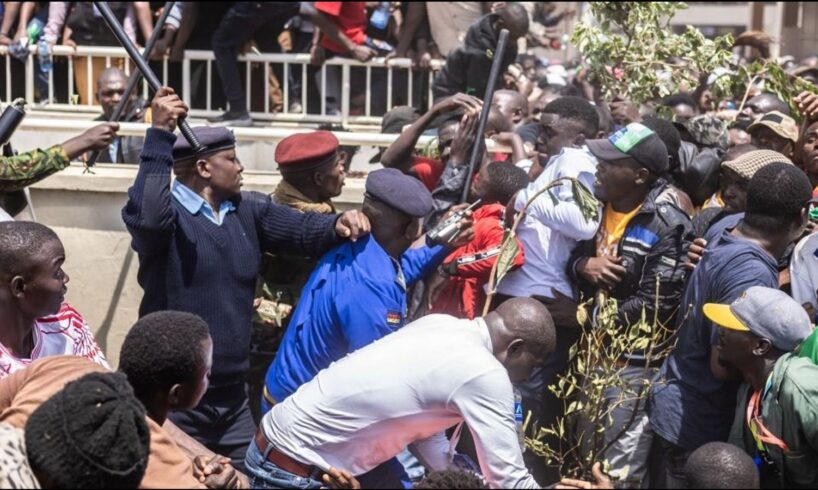
Nothing could more starkly capture the political and moral bankruptcy of Raila Odinga’s legacy than the massacre that unfolded at his funeral, carried out by the “broad-based” Kenyan government he helped forge.
Yesterday, Odinga’s body was flown into Nairobi from India, where he had travelled for top medical treatment, setting into motion the events that culminated in state security forces opening fire on mourners. By the end of the day, at least four of them lay dead.
Security forces attacking mourners at the State Funeral for former Kenya prime minister Raila Odinga at Nyayo National Stadium in Nairobi, Kenya, October 17, 2025 [AP Photo/Samson Otieno]
For over four decades, Odinga stood at the centre of Kenya’s corrupt bourgeois politics. As the World Socialist Web Site noted in its obituary, Odinga’s chief skill was his ability to contain and redirect social opposition to the Kenyan ruling class and imperialism. Whenever mass discontent erupted against inequality, austerity and imperialist domination, he stepped in to channel it into the safe confines of constitutional reform and corrupt power-sharing deals to preserve the interests of the ruling elite.
Through successive alliances—with Mwai Kibaki after the 2007–08 post-election bloodshed that left over 1,200 dead and 650,000 displaced, with Uhuru Kenyatta in the 2018 “handshake,” and finally with today’s ruler William Ruto in 2024’s “broad-based” government—Odinga repeatedly suppressed social opposition to the Kenyan ruling class. His immense personal fortune, estimated at up to $3 billion, symbolizes the looting and corruption of Kenya’s post-independence elite, based on deepening poverty for the masses.
Raila Odinga in 2012 [Photo by CSIS / Flickr / CC BY-NC-SA 2.0]
Odinga died in Kerala, India, at 80, reportedly of cardiac arrest while undergoing therapy in hospital. His body was repatriated and landed at Nairobi’s Jomo Kenyatta International Airport yesterday, amid a massive surge of mourners across the city who overwhelmed the planned ceremonial reception.
As the coffin was unloaded, thousands of grieving supporters pressed through airport barriers waving branches and palm fronds, a symbol of mourning among the Luo ethnic group to which Odinga belonged, temporarily bringing the seventh busiest airport on the continent to a halt.
Initially, the plan was for the public viewing to be held at parliament grounds, but authorities abruptly shifted it to Kasarani Stadium in northeast Nairobi. From the airport, thousands of mourners moved in a procession to escort the vehicle carrying the body to the stadium.
At Kasarani, chaos quickly escalated. When mourners surged forward in an attempt to view the body, security forces responded with live ammunition and tear gas. Gunshots rang out, even audible on the live YouTube broadcast linked to the presidency, before the footage cut out. At least four people have been killed in the carnage, among them Vincent Otieno Ogutu, 40, a father of three.
Loading Tweet …
Meanwhile, inside the stadium, President William Ruto and senior officials were confined to a secure room, safeguarded from the unfolding police violence.
Deputy President Kithure Kindiki, who chairs the funeral planning committee, later held a press briefing but made no mention of the killings or the chaos. But the massacre has shown that the Ruto government is so hostile to the masses that it cannot even conduct a funeral without bloodshed.
Since Odinga’s death was announced, the leaders of Kenya’s political establishment, joined by their international counterparts, have rushed to hail him as a national hero. Ruto eulogised Odinga as “a true statesman, a giant of democracy, a fearless freedom fighter, and a tireless warrior.”
His words came a day after he used the opportunity provided by Odinga’s death and its wall-to-wall coverage to impose eight deeply authoritarian, anti-working-class bills.
These include the Privatisation Bill 2025, enabling the sell-off of state enterprises without parliamentary oversight; the Computer Misuse and Cybercrimes (Amendment) Bill 2024, giving police vast powers to monitor and shut down online activity; and the National Police Service Commission (Amendment) Bill 2024, tightening presidential control over the security apparatus. New land and tax amendments facilitate elite land grabs and impose new levies on workers.
Former President Uhuru Kenyatta—the scion of one of Kenya’s richest families, whose vast fortune originates in the mass land looting carried out by his father, Jomo Kenyatta, in the 1960s and 1970s—mourned Odinga as “a father to the nation, a steadfast champion for the people, and a true son of Kenya.”
President Uhuru Kenyatta, his Deputy William Ruto, with former Prime Minister Raila Odinga and his running mate Kalonzo Musyoka at State House in Nairobi, April, 2013 [Photo: State House Kenya]
Martha Karua played a leading role in defending the fraudulent victory of Mwai Kibaki in the disputed 2007 elections that pitted Kibaki against Odinga, and who later became Odinga’s running mate in the 2022 elections. Now posturing as an opposition figure to the Ruto regime that Odinga himself helped install, she hailed him as “a man of courage who never stopped believing in dialogue, democracy, and the Kenyan dream”.
Kalonzo Musyoka, who was the National Organising Secretary of the Kenya African National Union—the sole-party under the dictatorship of Daniel arap Moi when Odinga was being beaten up in Moi’s torture chambers—recalled how Odinga “resolved that the tears and painful scars he personally suffered would yield to democracy and freedom for his beloved Kenya.”
On the international stage, far-right Hindu supremacist Narendra Modi, Prime Minister of India, called Odinga “a towering statesman and a cherished friend of India.”
South African President Cyril Ramaphosa, himself a former trade union leader turned billionaire, hailed Odinga’s “unwavering commitment to his people and continent.”
Tanzanian President Samia Suluhu Hassan, who is savagely repressing opposition on the eve of Tanzania’s elections and who recently ordered police to sodomise Kenyan activists who travelled to Tanzania to support the opposition, called Odinga’s death “a loss not only for Kenya but for all of Africa.”
Somalia’s President Hassan Sheikh Mohamud declared, “Somalia stands in solidarity with Kenya in this moment of grief.” Just weeks ago, the Odinga-backed government in Nairobi whipped up anti-Somali chauvinism to deflect mounting domestic anger.
Odinga is being hailed as a great democrat. Without a doubt, the tens of thousands who poured into Kasarani Stadium and who gathered today in the western Kenyan city of Kisumu to pay their respects are sincere. They believe that Odinga helped to democratise Kenya, that he fought for freedom. But sincerity does not change reality.
Odinga’s three decades of manoeuvring between opposition and government helped give birth to the Kenya of today: where 36 percent, about 20 million people, are undernourished; 67 percent of youth are unemployed or underemployed; 60 percent of the country’s annual revenue is used for debt servicing to international finance; and fewer than 0.1 percent of Kenyans (about 8,300 people)—including the Odinga, Kenyatta and Ruto families—own more wealth than the bottom 99.9 percent (over 44 million people).
As for democracy, the Ruto government that Odinga backed routinely suppresses peaceful protests against International Monetary Fund-dictated austerity with live ammunition, teargas, and abductions. At least 160 people have been killed by police and military units, hundreds maimed, thousands arrested, and over 300 charged under draconian anti-terror laws. Dozens have been abducted and “disappeared,” their families left without answers.
Odinga, Prime Minister of Kenya, with, from left, Pierre Nkurunziza, President of Burundi, Bingu Wa Mutharika, President of Malawi, Thabo Mbeki, President of South Africa, Klaus Schwab, Founder and Executive chairman, World Economic Forum, and John Agyekum Kufuor, President of Ghana, during the Opening Plenary of the World Economic Forum on Africa 2008 in Cape Town, South Africa, 4 June 2008 [Photo by Eric Miller / CC BY-SA 2.0]
The media eulogies for Odinga, solemn state ceremonies, and orchestrated unity among Kenya’s political elite is a tribute to one of the principal architects of the social and political disaster facing the Kenyan masses. It is meant to conceal the decay of the social order he helped sustain.
If there is a lesson in Odinga’s death, it is that Kenya’s future cannot be built through the politics of bourgeois nationalism, but only through the independent struggle of workers and youth against the capitalist order that Odinga, to his final breath, defended.
This struggle cannot be confined within the artificially created colonial borders of Kenya. It can only be carried out as part of an international socialist movement of the working class, uniting workers across Africa and the world in a common fight against capitalism, imperialism, and all forms of oppression.
Sign up for the WSWS email newsletter
